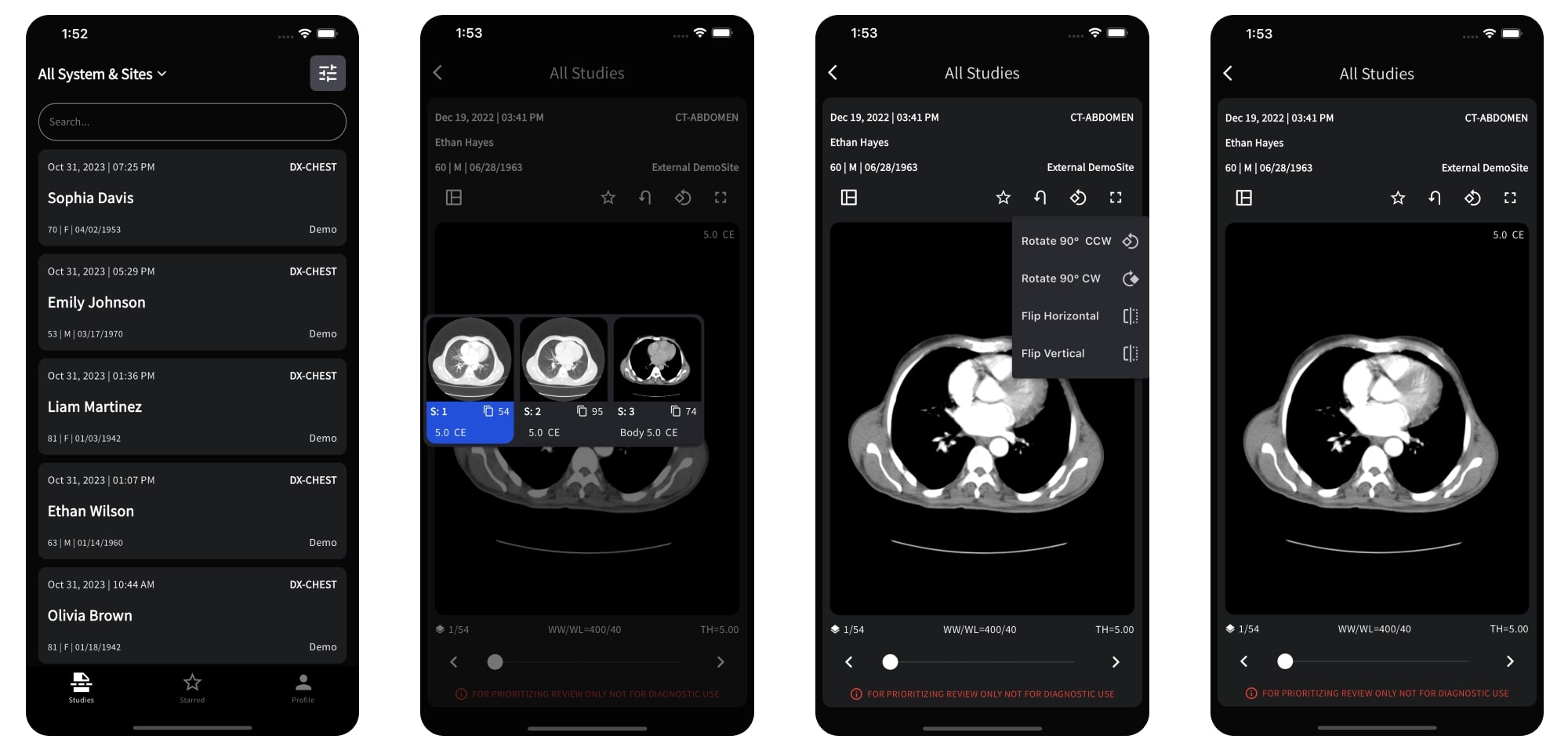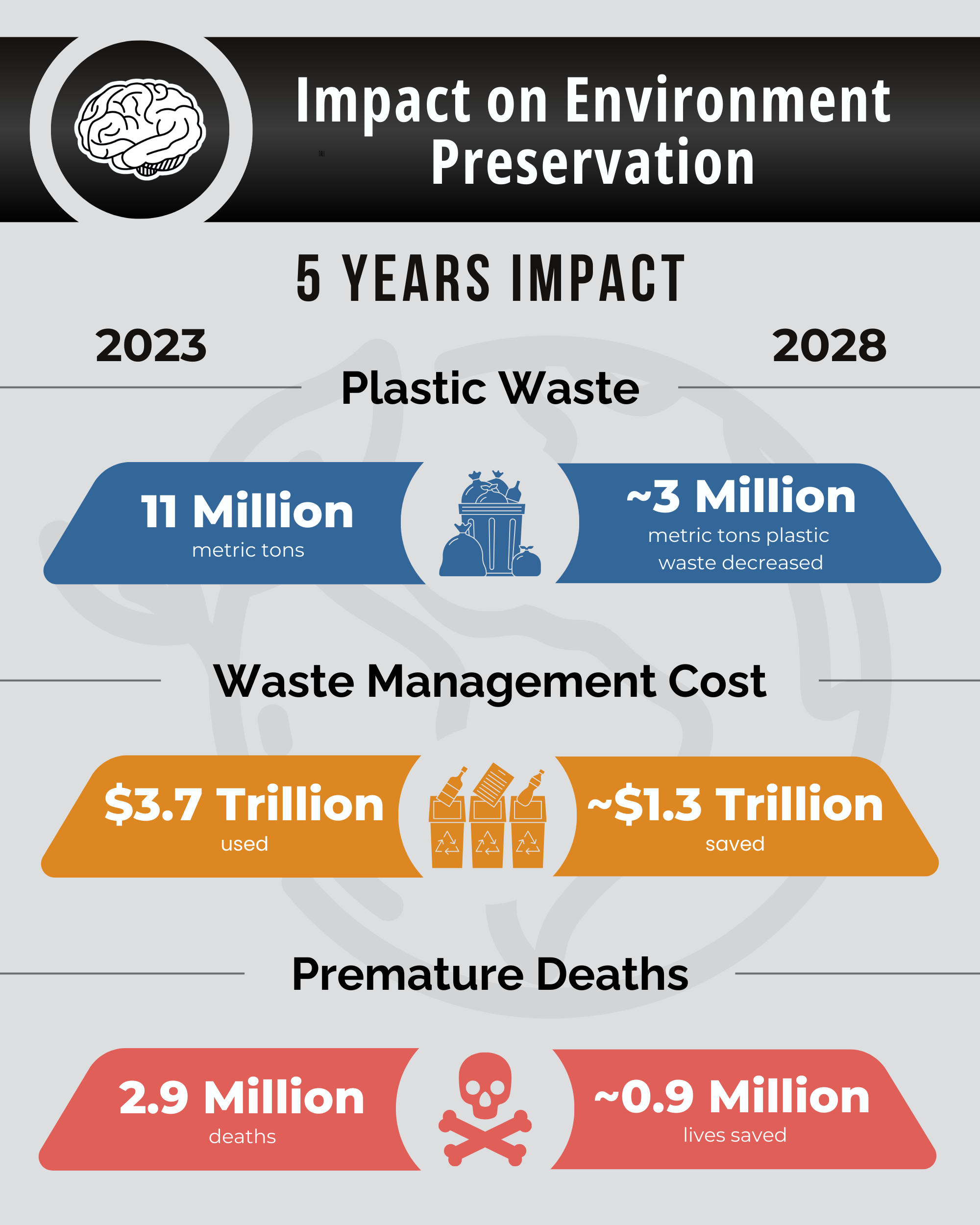Proposal prepared for Tara Climate Foundation
Executive Summary
- 🌟 Vision: To revolutionize radiological imaging, envision a world where RadioView.AI application replaces films, offering equivalent precision and contrast, while championing environmental conservation.
- 🚀 Mission: Our mission is to introduce RadioView.AI application for precise imaging, replacing films, and driving eco-friendly practices in radiology.
- 🌱 Project Impact on Environment ~300 million tons decrease in plastic waste, $1.3 trillion reduction in waste management costs.
- 🤝 The Driving Force: The Institute of Health Innovation and Education, a registered non-profit organization in the Texas, United States
- 📈 Current Progress: We have initiated the working from Pakistan. Application and System Integration:
- Completed in 02 hospitals
- Working under progress in 09 hospitals
- Planned to be initiated soon in 04 hospitals
- ⏰ Future Plans: We are ready to integrate our application in more hospitals as soon as grants are received.
- 📍 Rollout Strategy: Commencing in Pakistan, Bangladesh, and India, our mission is to extend this Environmental Friendly Technology for free to all Low- and Middle-Income Countries, creating a ripple effect of positive change.
- 💵 Funding Request: Unlock the future of green health with a grant of $2 Million, representing approximately 50% of the total project cost.
Why Tara Climate Foundation?
The vision of our organization aligns with the Tara Climate Foundation’s commitment to environmental stewardship. By democratizing medical imaging and eliminating the need for radiology films, we contribute to the foundation’s goal of promoting practices that safeguard both lives and the environment.
Based on these reasons, we strongly believe that the vision and strategy of Institute of Health Innovation & Education and Tara Climate Foundation align perfectly.
Link to the full proposal: ihie.io/taraclimatefoundation
Project Budget and Funding Request
| Area | Cost |
|---|---|
| Edge Devices | $400,000 |
| Local servers | $400,000 |
| Implementation and maintenance cost | $100,000 |
| Miscellaneous & Administration | $100,000 |
| Cloud Credits | $500,000 |
| Human Resource | $500,000 |
| Donation by NEUROCAREAI INC. – DICOM Server Software backend – Cloud DICOM software backend – NeuroICH Module – Frontend Radiology viewer (Web/Desktop) – Frontend Radiology viewer (Mobile) – Frontend Critical Notification System | ~$2 million |
| Total Cost of the project | ~$4 million |
| Funding Request | $2 million |
Goal
To transform radiological imaging by replacing films with the RadioView.AI application, maintaining accuracy while promoting environmental conservation.
Gap Analysis and Proposed Solution
Currently, 353 million tonnes of plastic waste is generated annually worldwide. Projections indicate that these figures are predicted to increase four times, reaching an estimated 1 billion tonnes of plastic waste by the year 2060 (Fleck A, 2022). Globally, approximately 2 billion radiographs are generated annually, encompassing CT scans, mammograms, and chest X-rays, with the medical field consuming 94–98% of these films (Hilal N et al., 2022).
Radiographic films employed in medical applications consist of a polyester sheet coated with a thin gelatin layer infused with silver grains. Traditionally, chemical processing and incineration have been the primary methods for disposing of X-ray films. However, incineration results in a significant loss of valuable silver, approximately 25–30%, and the emitted smoke is both illegal and highly toxic. Consequently, X-ray photographic films, which contain silver, are considered hazardous waste due to their toxicity (Hilal N et al., 2022; Thrall JH et al., 2023).
Plastic additives used in radiological films are recognized as endocrine disruptors and carcinogens (Veitch A, 2021). These chemicals pose a significant threat to human health primarily through skin contact (leading to dermatitis), ingestion, and inhalation (Aalto-Korto K et al., 2019). Microplastics, considered hazardous pollutants, can enter the food chain when ingested by various marine and freshwater organisms, causing a range of health issues. Consequently, when humans consume animals exposed to plastic additives and microplastics, they may face potential harm. Biomonitoring studies on human tissues have detected plastic components, highlighting the presence of these environmental contaminants in the human population (Adeniran AA & Shakantu W, 2022).

Figure 1: Only recycling is not enough to solve plastic waste generation and its impact on environment (Fleck A, 2022)
Statistics from Organization for Economic Co-operation and Development (OCED) show that a mere 9% of plastic waste is currently subjected to recycling efforts, leaving a staggering 91% to become a harmful presence in our environment. Even more worrisome is the prediction that even if we intensify our recycling endeavors, a substantial 83% of the world’s plastic waste would persist in the environment, continuing to inflict damage (OCED, 2019). This dire situation underscores the urgent need for comprehensive solutions that go beyond recycling and focus on reducing plastic consumption to address the prevalent issue of plastic pollution and its adverse impacts on our planet (Figure 1).
Report released by The Lancet Commission on Pollution and Health, Global Alliance for Health and Pollution states: “In 2015, diseases caused by air, water and soil pollution were responsible for 9 million premature deaths, that is 16% of all global death. Exposures to contaminated air, water and soil kill more people than smoking, hunger, natural disasters, war, AIDS, or malaria” (Cohen S, 2017). Approximately 92% of these deaths were reported from LMICs (The Lancet Commission on Pollution and Health, 2017). Therefore, this highlights the pressing need to mitigate pollution and its resultant health impacts on a global scale, with a heightened sense of urgency, particularly in LMICs (Figure 2).


Figure 2: A. Statistics for global mortality attributed to pollution, B. Statistics for distribution of pollution attributed mortality among low/middle income and high income countries.
Artificial Intelligence (AI) is revolutionizing numerous fields, including biomedical research, healthcare systems, and environmental conservation (Castiglioni I et al., 2021; Gore JC, 2020). In this project, we propose the integration of the digital technology “RadioView.AI Application” into clinical settings, offering the potential to eliminate the need for radiology imaging films. Our partner company, NeuroCareAI, has developed this groundbreaking model and is committed to offering it at no additional cost to Low- and Middle-Income Countries (LMICs).
By implementing RadioView.AI within healthcare settings, we can significantly reduce the waste generated from radiology films, consequently mitigating their environmental impact. Moreover, this technology will streamline the delivery of care, reducing treatment time and ultimately leading to improved patient outcomes for patients. Our cutting-edge solution has the power to disrupt traditional approaches, simultaneously benefiting the environment and healthcare, marking a significant step towards a more sustainable and efficient future.
What is RadioView.AI ?
The RadioView.AI application revolutionizes medical imaging by offering seamless access to various scans like MRI, X-rays, and CT scans with unparalleled accuracy and contrast akin to traditional radiology films. This transformative tool not only optimizes patient care delivery, facilitating swift and efficient diagnoses but also champions environmental conservation by eliminating the need for radiological films. By harnessing RadioView.AI, healthcare providers streamline their processes while significantly reducing the ecological footprint associated with film-based imaging, marking a crucial stride toward a more sustainable healthcare landscape.
Project Aim
The project aims to implement RadioView.AI in hospitals, introducing a digital platform for viewing scans to revolutionize care delivery and promote environmental sustainability. By eliminating the need for radiology films, we significantly reduce environmental pollution.
Prototype Image

Figure 3: Prototype image of the RadioView.AI application showing user interface
Environmental Impact of the Project
- Environmental Sustainability: By eliminating the need for radiology films in stroke care, the project significantly reduces environmental pollution associated with film production and disposal. This eco-conscious approach aligns with global efforts to reduce healthcare’s environmental footprint, contributing to a healthier planet.
- Reduced Carbon Footprint: By eliminating radiology films, the project reduces the carbon footprint associated with film production, transportation, and disposal. This reduction in healthcare-related environmental impact aligns with global efforts to combat climate change.
- Improved Health: Embracing eco-friendly solutions in healthcare holds immense promise for improving public health on a global scale. By reducing our reliance on fossil fuels and transitioning to cleaner, renewable energy sources, we can significantly reduce air pollution, resulting in fewer cases of respiratory diseases, cardiovascular problems, and even premature deaths.
- Decrease in Plastic Waste: The project anticipates a noteworthy environmental achievement, aiming to reduce plastic waste by approximately 300 million tons (UN Foundation Report 2023). This ambitious goal signifies a significant stride in curbing the detrimental impact of plastic pollution on our ecosystems.
- Reduction in Waste Management Costs: A key economic advantage of the project lies in its potential to bring about a substantial reduction in waste management costs, estimated at approximately $1.3 trillion (World Wildlife Fund, 2023). This financial efficiency not only promotes sustainable practices but also addresses the economic burden associated with waste management on a global scale.

Figure 4: Impact of RadioView.AI App implementation on environment preservation
Current Progress
We have already started the integration of the application in various hospitals and medical centers of Pakistan.
Integration Completed
| SNo. | Site | Type |
|---|---|---|
| 1. | Holy Family Hospital | Hospital |
| 2. | Sarwar Foundation Hospital | Hospital |
Integration Initiated and Currently in Progress
| SNo. | Site | Type |
|---|---|---|
| 1. | Rai Ali Nawaz Hospital | Hospital |
| 2. | Al-Madina Diagnostics | Radiology Center |
| 3. | Abid Imaging Center | Radiology Center |
| 4. | Bashir Diagnostic Imaging Center | Radiology Center |
| 5. | Sandho Diagnostic Center | Hospital |
| 6. | Modern Diagnostic Center | Radiology Center |
| 7. | Pak CT Scan Center | Radiology Center |
| 8. | Mian Diagnostics | Radiology Center |
| 9. | Ittefaq 3D CT Scan | Radiology Center |
Integration Process to be Initiated Soon
| SNo. | Site | Type | Status |
|---|---|---|---|
| 1. | Shifa Hospital | Private Hospital | Demo Given – Approved by HOD Neurology |
| 2. | Ghurki Hospital | Trust Hospital | Demo Given – Awaiting Response |
| 3. | Services Hospital | Teaching Hospital | Demo Given to HOD – Awaiting Administration’s Approval |
| 4. | Gulab Devi Hospital | Teaching Hospital | Demo Given – Awaiting HOD’s Response |
References
Aalto-Korte, K.; Suuronen, K. Plastic materials and glues. Contact Dermat. 2019, 2019, 1–28.
Adeniran, A. A., & Shakantu, W. (2022). The health and environmental impact of plastic waste disposal in South African Townships: A review. International Journal of Environmental Research and Public Health, 19(2), 779.
Castiglioni, I., Rundo, L., Codari, M., Di Leo, G., Salvatore, C., Interlenghi, M., … & Sardanelli, F. (2021). AI applications to medical images: From machine learning to deep learning. Physica Medica, 83, 9-24.
Cohen, S. (2017). The Human and Financial Cost of Pollution. https://news.climate.columbia.edu/2017/10/23/the-human-and-financial-cost-of-pollution/ (Accessed on September 19, 2023).
Fleck, A. (2022) Recycling Efforts Not Enough to Solve Plastic Waste Problem. https://www.statista.com/chart/27756/global-waste-management-projections/ (Accessed on September 19, 2023).
Gore, J. C. (2020). Artificial intelligence in medical imaging. Magnetic resonance imaging, 68, A1-A4.
Hilal, N., Tawfik, T. A., Ahmed, S. N., & Hamah Sor, N. (2022). The effect of waste medical radiology as fiber reinforcement on the behavior of eco-efficient self-compacting concrete. Environmental Science and Pollution Research, 29(32), 49253-49266.
Organization for Economic Co-operation and Development (OCED), 2019. https://www.oecd-ilibrary.org/sites/aa1edf33-en/1/3/1/index.html?itemId=/content/publication/aa1edf33-en&_csp_=ca738cf5d4f327be3b6fec4af9ce5d12&itemIGO=oecd&itemContentType=book#section-d1e841 (Accessed on September 19, 2023).
The Lancet Commission on Pollution and Health, Global Alliance for Health and Pollution, 2015. http://gahp.net/the-lancet-report-2/ (Accessed on September 19, 2023).
Thrall, J. H., Brink, J. A., & Zalis, M. E. (2023). The ESG (Environmental, Social, Governance) Movement and Radiology: Opportunities and Strategy. Journal of the American College of Radiology.
Veitch, A. (2021). Uniting the global gastroenterology community to meet the challenge of climate change and nonrecyclable waste.
About us: Why the Institute of Health Innovation and Education?
- Experience: Our team is founded by Junaid Kalia, a seasoned professional with extensive experience in creating innovative health technology products. With a proven track record of success in both Tajdeed.us and Revive Labs, he brings a wealth of knowledge and expertise to our team. Under his leadership, we are committed to delivering cutting-edge solutions that push the boundaries of what is possible in healthcare.
- Value: One of our key strengths is our ability to source global talent from Pakistan, India, the Philippines, and Vietnam at a highly cost-effective rate. This allows us to develop our solutions more efficiently and effectively than our competitors, while still maintaining the highest standards of quality and performance.
- Access: We have established a robust network of institutions in Pakistan that can provide both radiology and pathology data and are willing to integrate in real-time. Additionally, we are actively working with sites in India, the Philippines, and Vietnam to expand our network and access even more data. By leveraging this network, we can gain access to a wealth of clinical data, enabling us to develop more accurate and effective solutions.
- Clinical Network: Our clinical network is another key asset, providing us with expert assistance in data acquisition. We have a network of physicians in the US who can help us acquire the data we need to develop our solutions, ensuring that we have access to the highest quality data possible. With our clinical network, we can accelerate our development process and bring our solutions to market more quickly and efficiently than ever before.
 Saleema Ali, PhD.
Executive Director – Institute of Health Innovation and Education
Email | LinkedIn | WhatsApp
Saleema Ali, PhD.
Executive Director – Institute of Health Innovation and Education
Email | LinkedIn | WhatsApp
Appendix – IRS Letter
The need for modern care and education system has never been greater. Sign up for our newsletter.